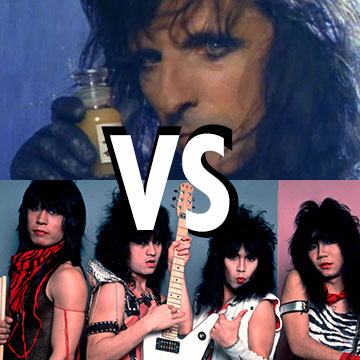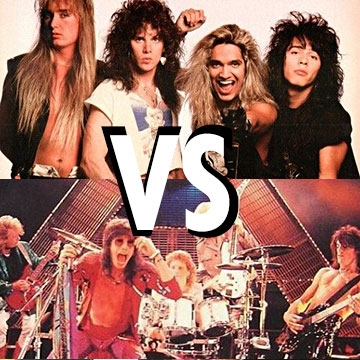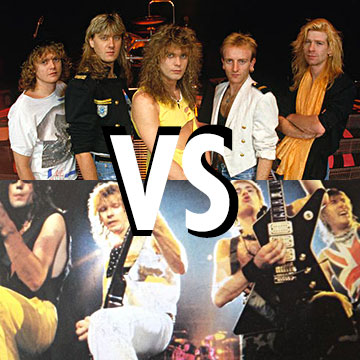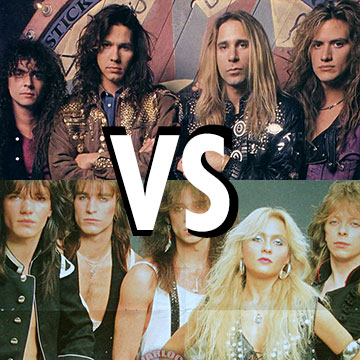first round game
(7) slaughter, "fly to the angels"
vs
(10) warlock, "all we are"
Read the essays, watch the videos, listen to the songs, feel free to argue below in the comments or tweet at us, and consider. Winner is the aggregate of the poll below and the @marchshredness twitter poll. Polls close @ 9am Arizona time on 3/6.
natasha padilla on slaughter's "fly to the angels"
1990 was a pivotal year in my life. I graduated from sixth grade in June and said goodbye to elementary school. One of my teacher’s had spent much of the year prefacing reprimands to the class with the shrill warning, “When you get to junior high…,” trying to get us in shape for the big leagues of lockers, homerooms and hundreds of new classmates come September. Still too young to stay home alone all day while my parents worked, I was enrolled in the pre-teen program at my day camp for the summer. I was 11 years old and awkward: one of the tall girls but not the tallest, big glasses, and even bigger, frizzy, curly hair with bad bangs. New Kids on the Block was my favorite group (I was a Donnie girl) and Step by Step had just come out. I listened religiously on my magenta Panasonic walkman every bus ride. And there were a lot of bus rides. Aside from the bus to and from camp, there were bus rides to most of the activities: water parks, amusement parks, lakes, mini-golf, movies on rain days, campgrounds—you get the idea. It was a fun and fortunate way to spend summer in the suburbs, and I met future classmates but many others who I’d only see each summer or never see again. Some kids were bussed in from New York City, and this was the summer I met Jill from Manhattan. She listened to rap, hard rock and hair metal. We became friends and she made me dubs of music she enjoyed, including Aerosmith’s Pump and Mötley Crüe’s Dr. Feelgood. These cassettes marked the beginning of my musical transformation, and MTV helped fan the flames.
Aerosmith, Mötley Crüe and their ilk were on MTV heavy rotation alongside pop stars like NKOTB and Madonna. Slaughter’s “Fly to the Angels” was one of many hair metal music videos ruling the Dial MTV countdown that summer. Previously, I’d enjoyed the occasional Bon Jovi, Def Leppard and Guns N’ Roses songs, but never considered myself a fan or cared enough to seek out rock music. Now, I was interested and paying attention to which songs I liked and disliked so I could talk about them with Jill, and maybe even introduce her to new music. “Fly to the Angels” got under my skin and the “Up All Night” chanting at the beginning of the video sounded cool and defiant, but not dangerous (I was a good kid and my parents were strict). That might sound foolish, but image was everything in the MTV era. Artists had to look the part if they were going to win over the hearts of teenyboppers like me, let alone appear in music videos, and hair metal was all about excess on every level. Glam it up, baby!
By 1990, the hair and makeup had softened. Men were starting to not look like women. Dr. Feelgood-era Mötley Crüe did not look like Theatre of Pain-era Mötley Crüe. Flesh & Blood-era Poison did not look like Look What the Cat Dragged In-era Poison. The hair was still long and poofy, but the lipstick and mascara were fading. Slaughter looked safe—safe for a Catholic girl who was still obsessed with Donnie, Danny, Joey, Jordan and Jonathan. Initially, I rejected Skid Row’s “I Remember You” because I was put off by bassist Rachel Bolan’s nose chain. The youth gone wild were a little too wild for me yet.
I had recently started buying cassingles, but Slaughter seemed worth the full-album commitment gamble since I already liked two songs and drummer Blas Elias and frontman Mark Slaughter were hot. (This was the reasoning of 11-year-old me.) On my next trip to the mall, I went to Sam Goody and bought Stick It to Ya. Slaughter was now part of the bus ride walkman rotation and “Fly to the Angels” was my favorite song. But why?
The song is about a girl and lost love—subjects already in my wheelhouse from years of saccharine pop like New Kids on the Block’s “Please Don’t Go Girl.” Mark Slaughter’s voice truly sounded tortured. I felt it when he sang, “I try to convince myself that the pain, the pain it’s still not gone,” and boy, did he linger on that “PAAAIINN” (twice). I used to take pleasure in shrilly singing along, with that line in particular, to annoy my friend Anna on the bus. It’d take another decade for Judas Priest’s “Painkiller” to become my favorite example of heavy metal pain.
In an interview with ClassicRockRevisited.com, Slaughter said the song is “about letting go of somebody who’s passed away.” The song is dedicated “In memory of Cyndi Romano” in the cassette liner notes. However, the “Fly to the Angels” music video would have you believe that the song is about female aviator Amelia Earhart, who disappeared during her attempted around-the-world flight in 1937. The woman and the aircraft in the sepia footage recall Earhart and the Lockheed Model 10 Electra she flew on her ill-fated expedition. Was Romano a pilot? Did she too perish in flight? Maybe the video is a tribute to Earhart and all the world’s gone-too-soon women like Romano? Or did the band just choose a heavy-handed music video concept?
They are rocking out in an airplane hanger next to a similar plane; Mark Slaughter is wearing a leather flight jacket for the occasion, and there’s a sky backdrop and the requisite long, blowing hair. Two of the three times Slaughter sings, “I’ll drive down this lonely, lonely road,” there’s a cutaway to him driving a vintage car down a road. Other featured hallmarks of the era include leather pants, Dana Strum’s studded guitar strap, an Ovation acoustic-electric guitar, headbanging, drumstick twirling, and Elias’ overblown drum kit, which is downright comical. Two useless drums behind him serve as advertising: one reads “Stick It to Ya,” the other “This space for rent.” Take that, Scott Rockenfield! Yeah, right.
Admittedly, Warlock’s “All We Are” video is much more entertaining with its terrible special effects: a 1.21 jigowatts of lightning nod and car explosion. That song is a fist-pumping anthem and singer Doro Pesch is a heavy metal legend, so putting it up against a latter-day hair metal band like Slaughter and a power ballad is a bit apples to oranges. I like both songs, but “Fly to the Angels” will always hold that special place in my heart. If you ever hear a girl singing it at a karaoke bar in NYC, that’s probably me. Say hi!
Natasha Padilla grew up in Rockland County, about 45 minutes outside New York City, and went to Gate Hill Day Camp. Her writing has appeared in publications including Metal Maniacs, ROCKRGRL, The Aquarian and MetalInsider.net. She loves music and wants Skid Row to win the tournament.
megan campbell on warlock's "all we are"
I was a mere metal dilettante back in the 1980s: a junior high kid who eagerly consumed whatever MTV offered in prime time, but rarely bothered with Headbanger’s Ball, even when I was allowed to stay up late. I was dimly aware of bands like Iron Maiden and Megadeth, and staunchly assumed that they were scary and I would hate them. My tastes were solidly in the Poison/Whitesnake/GnR camp, and often much more embarrassing than that (Winger’s “Seventeen,” anyone?). Thus, I began my Warlock/Doro journey as an adult, without the rosy glasses of fan nostalgia. I did, however, feel a tinge of righteous anger: Why was young me only shown the dude bands? Huh, MTV? Let’s talk about women in metal! Let’s talk about the dearth of female role models for my 13 year-old hair metal-loving self (because I did love it, until “Cherry Pie” killed that love by truly sucking, and “Smells like Teen Spirit” buried it by rocking out in a whole new, leather-free way). Why DIDN’T I know about Doro? She’s The Metal Queen of Germany, for fuck’s sake! BECAUSE OF THE MTV PATRIARCHY, THAT’S WHY!
Propelled by the general awesomeness of the video for “All We Are” (more on that later), I dove right into Doro Studies. But something unexpected happened: the deeper I dug in, the less I found. Doro is . . . incredibly earnest. She’s a vegan! She loves music, especially rock music, of course. She LOVES her fans. She donates heavily to a charity for women and girls. She has some training in graphic design, and she paints in her free time. She loves martial arts, especially obscure ones, like Filipino stick fighting. As an aside to all of these fascinating facts, she needs you to know that no one ever treated her badly: the men were all so respectful! At a certain point I was confronted with an uncomfortable dual realization: Doro truly was the role model my dumb and undiscriminating teen self needed, but that same self would have had no interest in her.
Young Dorothee Pesch was only 16 when she started her first band, its name morphing from Snakebite to Beast to Attack, before finally settling on Warlock in 1982. The band’s lineup also shifted around: by 1982 it was comprised of Doro, Peter Szigeti, Michael Eurich, Thomas Studier, and Rudy Graf. They found a manager and recorded their first album, Burning the Witches, in 1984. Two more albums—Hellbound and True as Steel—followed, along with some success among the metalheads of Europe. The single “Fight for Rock” (off of True as Steel) got American airplay as well. In 1986, Doro was the first woman to front a band at a Monsters of Rock show—it was held at an English castle and Warlock played with Motorhead, Def Leppard, Ozzy Osbourne, and the Scorpions.
Triumph and Agony, generally considered their breakthrough album, appeared on the scene in 1987. Warlock had an almost entirely new lineup by then, as Graf, Szigeti, and Rittel had all left and been replaced by Niko Arvanitis, Tommy Bolan, and Tommy Hendriksen. Doro, with her long blond locks and truly excellent rock vocals, was the band’s main draw, a fact emphasized by the album’s GLORIOUS album art:
Two singles from the album made it into heavy rotation on Headbanger’s Ball: “All We Are” and “Fur Immer,” a German-language track with a video set in the Louisiana bayou. However, the album fell a bit flat with US audiences. Metal purists found it too poppy, and its crisp production had none of the genre’s trademark sludginess.
Thirty years on, Triumph and Agony feels like an absolute time capsule from its era: short (just 40 minutes in total), with that careful mix of wheat and chaff I associate with The Time Before Cassingles (to say nothing of iTunes). There are a few stadium-ready rock bangers, a couple of power ballads, and a “political” song (“East Meets West,” the album’s weakest effort, ahem). Triumph and Agony wears its mainstream ambitions on its sleeve, which had to be one more mark against it in the metal community. I personally listened VERY KEENLY to lyrics like “My heart is a lion / That no-one can tame” (from the middling power ballad “Make Time for Love”) hoping to glean a little more insight into Doro’s mind; my only observation is that she, along with her band, had rather perfunctory feelings about ballads. By 1988, Doro was the only original member of Warlock left in the band—she fought to retain the name, but eventually bowed to record company pressure and changed it to, simply, Doro. She has continued to both tour and occasionally record, including a 2000 album titled Calling the Wild, which features a cover of Billy Idol’s “White Wedding.” Doro wears a white wedding dress in the enjoyably Goth-lite video, but I couldn’t help but note that there is no groom:
Warlock/Doro’s career bio is the essence of moderate, workmanlike musical success, but let’s forget about that for now. Instead, travel with me to 1987 Los Angeles, specifically the LA River Basin, setting of the video for “All We Are.” There weren’t a lot of great hair metal videos as of 1987 (fight me)—I mean, there’s Ratt’s “Round and Round,” some Van Halen, and then a lot of bands trying (and failing) to re-create the antic level of David Lee Roth. But this video? This is a great video. A ghoulish warlock magically stalls a stretch of LA traffic, and beams Doro and band onto a makeshift stage. There’s a shot of Doro’s leather-clad crotch, which I am going to go ahead and call feminist crotch parity. There’s a gratuitous explosion. Eventually, the stunned drivers and passengers exit their vehicles and begin to ROCK, because this was before we were all dead inside. “All We Are” is absolutely the best track on Triumph and Agony, a call to rebellion that aims higher than teen clichés: “I know you know we’re all incomplete / Let’s get together and let’s get some relief.”
Because I’d never seen this video before last summer, I embraced Warlock with a welcome surge of “There’s cool stuff I never knew about!” energy. I suppose on some level I was hoping to unearth some L7-style, tampon-throwing, riot grrl anger. But not so much. Interviews with Doro (at least, the ones in English, which is not her first language) have a numbing sameness. In them, she pleads her love of music, politely demurs to answer women-in-rock type questions, and praises her fellow musicians, often including nice anecdotes about Blackie Lawless (of W.A.S.P.) and Lemmy from Motorhead. She says things like: “That’s really why I’ve never been married or had any kids; the music is always the most important thing to me. And the fans! Music is always what I wanted to do.” The wall around her personal life is inviolable, the interviewers deferential.
One of the only upsides to my long and storied love/hate relationship with the website Jezebel is its frequent dissection of the Cool Girl archetype. You know her: she’s a girl but she’s, like, cool. She likes sports! She not prissy about her hair, like other girls. She HATES drama, just like you! She won’t get after you for going out with your friends too much, or drinking too much, or whatever too much. She also will daintily refrain from parsing the point at which coolness becomes inextricable from self-abnegation. I’m as guilty as anyone of Cool Girl-ing my way through my 90s youth, and it was such a relief when someone put a name to this particular coping mechanism. Thus, adult 2018 me has to wonder: is Doro truly an earnest, rock-loving German born under a lucky star, or is she Cool Girl-ing us all?
She was certainly careful never to allow herself to be portrayed as a plaything—the ignominious and inevitable fate of video girls and groupies, who must have represented about 99% of hair metal-adjacent women. Remember that album art? Multiple sources thoughtfully noted that it was created with her full consent, thank you very much. Videos and other footage of her with the various members of Warlock always depict an easy camaraderie—no winking machismo on the part of the men and no cutesy deferring to the lads from Doro herself. But also no real sense of who she is.
As far as I can remember, I shed my desire for a leather bustier and donned my 90s flannel without any lingering sadness. But this left my teenaged assumptions about hair metal more or less unexamined. My junior high self had eagerly bought into a party-hard narrative that I now realize was mostly a fiction (as well as particular to hair metal; real metal is nerdy). Hair metal required not just leather and guitars, it also demanded a carefully cultivated veneer of loucheness, one that was sometimes real (ahem, RATT), sometimes tragic (Steven Adler, Robbin Crosby, Steve Clark, Jani Lane), but often just a pose—a pose that Doro (and women in general) were wise to avoid. In fact, I wonder if it’s a pose even available to women. Drinking, drugging, and banging groupies (of any gender) certainly wouldn’t have added to a woman’s cachet in the 1980s (and maybe not now, either). Once I started looking, I couldn’t help but notice that the metal women of the 80s treaded carefully indeed around this issue. Take, for example, the Vixen video for “Edge of a Broken Heart,” one of the best-known hair metal tracks by a female band. It features them performing in sexy costumes, sure, but the off-stage footage includes such wild and crazy things as working out, cavorting in a kids’ playground, riding a tour bus with pen/notebook in hand, and chastely kissing their producer Richard Marx on the cheek.
It’s probably not surprising that the virgin/whore dichotomy (which is what we’re talking about here) applies to hair metal, but for me it brings up a more complex problem: if women in hair metal were chiefly depicted as party favors for male band members, then what exactly was the role of women musicians in this genre? Refusing to be objectified is well and good, but where does it leave you? If we believe Doro—unmarried, childless Doro, with her extra long pale blonde hair—there was plenty of room on the stage for hair metal women. But where is the space for them in our collective memories of hair metal, amid all the cleavage shots and penis shaped microphones and hip thrusts? If women had to sidestep so many of the trappings of the genre, doesn’t it become a little too easy for the memoirists and cultural historians and music writers to sidestep them and decide: Well, she wasn’t really hair metal. Or metal. Or anything.
And so we are left with: Doro the Unknowable, Doro the Pure. Musician. Vegan. Painter. Leather bustier-wearer (the bustiers are custom made of vegan pleather by fairly paid artisans). No one ever treated her badly, okay?
Megan Campbell is one half of the official March Shredness Selection Committee and the proprietor of Bad Cholla Vintage.








